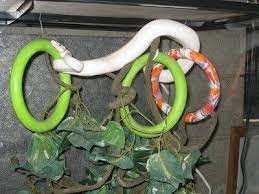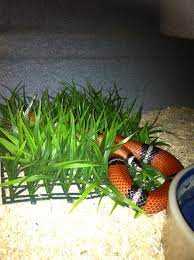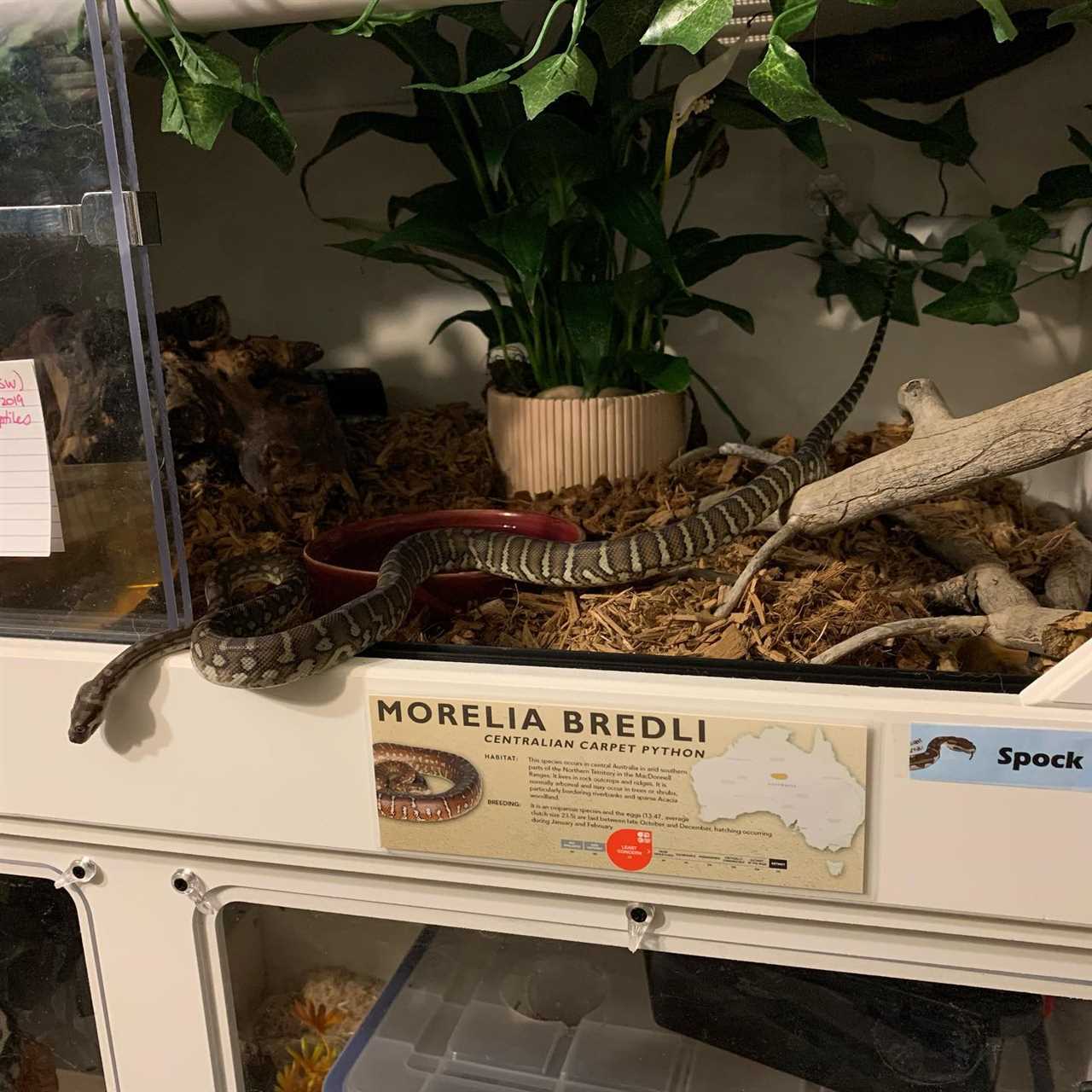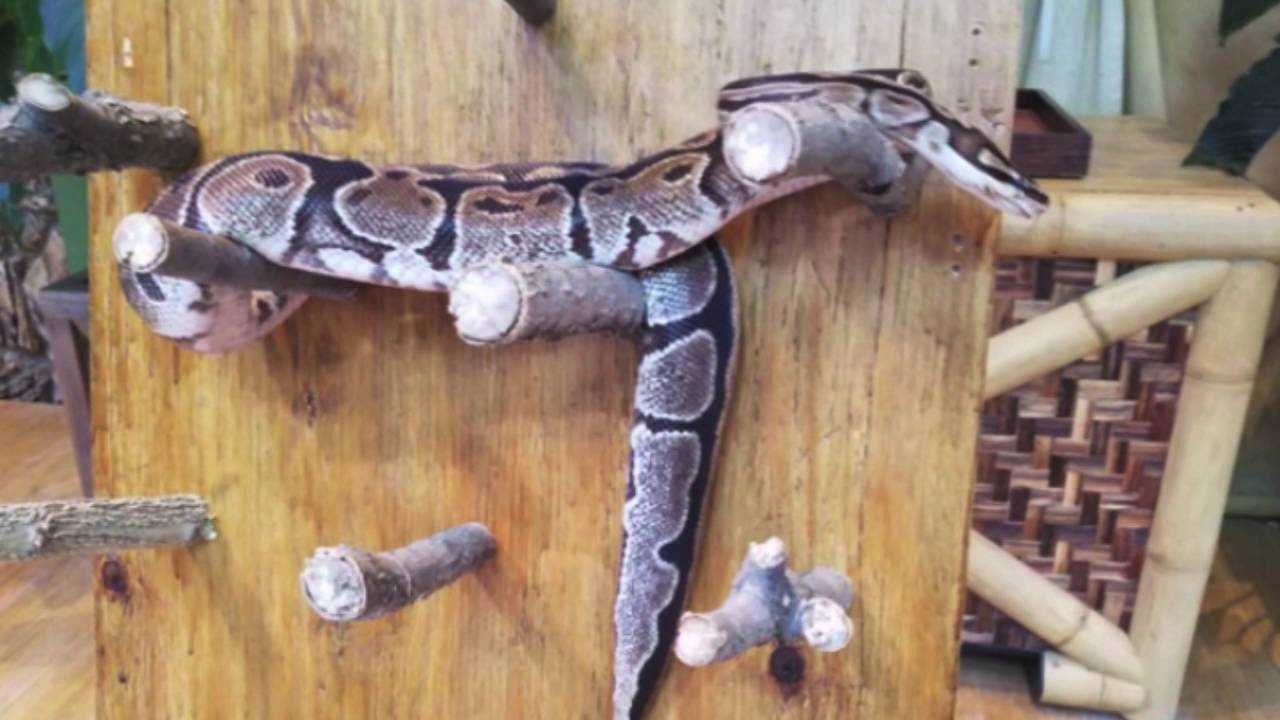Basking areas are another important aspect of snake enrichment. Snakes, being ectothermic animals, rely on external heat sources to regulate their body temperature. Providing them with a designated basking spot, such as a heated rock or a warm branch, allows them to thermoregulate effectively and imitates their natural basking behavior.
Why Snake Enrichment Is Important for the Well-being of Your Pet

Snake enrichment plays a crucial role in ensuring the overall well-being and happiness of your pet. Providing a stimulating and enriching environment for your snake can help prevent boredom, stress, and related health issues. Just like any other animal, snakes require mental and physical stimulation to thrive in captivity.
The Importance of Hideouts
Introducing Novel Objects for Stimulation
In addition to providing hideouts, offering novel objects for exploration and stimulation is another important aspect of snake enrichment. You can provide a variety of toys, such as climbing branches, textured surfaces, or puzzle feeders, to keep your snake engaged and mentally stimulated. These objects can mimic natural elements found in the wild and encourage your snake to exhibit behaviors similar to its natural habitat.
Utilizing Sensory Enrichment Strategies
Snakes rely heavily on their senses, especially their sense of smell and heat detection, to navigate and interact with their environment. Utilizing sensory enrichment strategies can be highly beneficial for your snake’s well-being. You can introduce different scents, such as herbs or spices, to create a more engaging and stimulating environment. Additionally, providing basking spots with adjustable temperature gradients allows your snake to thermoregulate and experience different heat levels, mimicking their natural habitat.
Overall, snake enrichment is essential for the physical and mental health of your pet. By providing hideouts, introducing novel objects for stimulation, and utilizing sensory enrichment strategies, you can ensure that your snake lives a happy and fulfilling life in captivity.
Create a Natural Habitat for Your Snake
Creating a natural habitat for your snake is an essential aspect of providing enrichment for their overall well-being. Snakes are natural explorers, and their environment should reflect this by offering a variety of toys, branches, caves, hides, rocks, tunnels, hideouts, and logs.
Additionally, adding branches and logs for your snake to climb and explore can mimic their natural habitat. Snakes will often climb and perch on branches to observe their surroundings, so providing these opportunities is essential for their mental and physical stimulation.
The substrate you choose for your snake’s enclosure can also contribute to their natural habitat. Opt for substrates that mimic their natural environment, such as mulch or coconut husk. These substrates allow snakes to burrow and dig, which is an integral part of their natural behavior.
By creating a natural habitat for your snake, you are providing them with the opportunity to express their natural behaviors and instincts. This not only keeps them physically active but also stimulates their mind, resulting in a happy and healthy snake. Remember to monitor your snake’s physical and mental health regularly and consult with a professional if you have any concerns.
Provide Proper Lighting and Temperature
Basking Spot
Snakes require a basking spot within their enclosure where they can actively seek out and absorb heat. This area should be equipped with a heat source, such as a heat lamp or heat mat, that provides a consistent and controlled temperature. The basking spot should reach a temperature of around 85-90 degrees Fahrenheit (29-32 degrees Celsius) for most snake species.
Hideouts
In addition to the basking spot, it is essential to provide your snake with a variety of hideouts throughout its enclosure. These hideouts can be in the form of logs, hides, toys, tunnels, branches, or rocks. Snakes need places to retreat to when they feel stressed, threatened, or simply want to rest. Having multiple hideouts allows your snake to choose its preferred hiding place and feel secure in its surroundings.
A table can be a useful tool for organizing and tracking the temperature and humidity levels in different areas of the enclosure. This will help you ensure that the basking spot and hideouts provide the appropriate temperature gradient for your snake’s comfort and overall well-being.
Offer a Variety of Hiding Places
Providing a variety of hiding places for your snake is essential for their overall well-being and mental stimulation. Snakes are natural burrowers and enjoy having places to hide and feel secure.
There are several options you can consider when creating hiding places for your snake. One option is to provide caves or basking spots where they can retreat to for privacy and comfort. These caves can be made from various materials such as rocks, logs, or even specialized snake hides that are available in pet stores.
In addition to caves, you can also create hideouts using tunnels or branches. These can be placed in the enclosure to provide different levels of hiding places and opportunities for your snake to explore. The branches can also serve as climbing surfaces, adding another dimension to your snake’s environment.
Furthermore, it is beneficial to have multiple hiding places in different locations within the enclosure. This allows your snake to have options and variety when choosing where to go. It is also important to consider the size of the hiding places and ensure they are appropriate for your snake’s size and species.
| Benefits of Providing Hiding Places for Your Snake |
|---|
|
Remember to regularly clean and inspect the hiding places to ensure they are free from dirt, debris, and potential hazards. This will help maintain a clean and safe environment for your snake.
Conclusion
Offering a variety of hiding places, such as caves, basking spots, rocks, hides, hideouts, tunnels, branches, and logs, is crucial for the well-being and happiness of your snake. These hiding places provide essential mental stimulation, privacy, and opportunities for natural behaviors. Carefully selecting and arranging these hiding places within the enclosure will create a comfortable and enriching environment for your snake to thrive in.
Create a Natural Habitat for Your Snake
One of the most important aspects of snake enrichment is creating a natural habitat that mimics their natural environment. This allows them to feel safe and secure while also providing opportunities for mental and physical stimulation.
When setting up your snake’s enclosure, consider adding various tunnels, logs, hides, branches, and rocks for them to explore and hide in. These provide places for your snake to climb, slither through, and hide, which are all natural behaviors for them.
You can use PVC pipes or specially designed reptile tunnels to create tunnels for your snake to explore. These tunnels should be secure and large enough for your snake to easily move through.
Logs and hides are another important addition to your snake’s habitat. These can be hollowed out logs or specially designed hideouts made of plastic or other reptile-safe materials. These provide your snake with places to retreat to and feel secure.
Lastly, consider adding rocks of various sizes and shapes to your snake’s enclosure. These can be used for climbing, basking, and hiding, and add visual interest to the habitat.
Table: Snake Enrichment Ideas
| Enrichment Idea | Description |
|---|---|
| Tunnels | Create secure tunnels for your snake to explore. |
| Logs | Add hollowed-out logs or specially designed hideouts for your snake to retreat to. |
| Branches | Provide sturdy branches for climbing and perching. |
| Rocks | Add rocks of different sizes and shapes for climbing, basking, and hiding. |
By creating a natural habitat with tunnels, logs, hides, branches, and rocks, you can ensure that your snake has a stimulating and enriching environment that promotes their well-being and happiness.
Provide Opportunities for Exercise and Movement
One important aspect of snake enrichment is providing opportunities for exercise and movement. Snakes are naturally active and agile creatures, and they require a stimulating environment to keep them physically fit and mentally stimulated. There are various ways you can encourage exercise and movement for your snake.
1. Create a Dynamic Enclosure
One way to promote exercise and movement is by creating a dynamic enclosure for your snake. This can include adding tunnels, caves, logs, rocks, basking spots, and branches for your snake to explore and climb on. These structures provide stimulation and encourage your snake to move around and explore its surroundings. Additionally, hiding spots or hideouts should also be provided to offer a sense of security for your snake.
2. Provide Toys

3. Encourage Hunting Behavior
Snakes are natural predators, and encouraging their hunting behavior can be a great way to promote exercise and movement. You can do this by using feeding techniques that require the snake to search for and capture their food. For example, hiding food items in different areas of their enclosure or using feeding puzzles can stimulate their natural hunting instincts and make mealtime more engaging.
4. Provide Adequate Space
It is essential to provide your snake with enough space to move around freely and stretch out its body. A cramped enclosure can restrict your snake’s movement and negatively impact its physical health. Ensure that the enclosure size is appropriate for the size and species of your snake. A general rule of thumb is that the enclosure should be at least the length of your snake’s body.
By incorporating these strategies, you can ensure that your snake has ample opportunities for exercise and movement. This will not only keep them physically fit but also mentally stimulated, leading to a happy and healthy pet snake.
Offer Enriching Feeding Techniques

Feeding time for your snake can be more than just providing them with a meal. By implementing a few enrichment techniques, you can make the feeding experience more engaging and stimulating for your pet.
Consider using branches, toys, caves, or basking spots to create a feeding station for your snake. These items can be strategically placed in their enclosure to encourage natural behaviors, such as climbing or exploring. You can attach their prey to a toy or hang it from a branch to mimic hunting behavior, providing mental and physical stimulation during feeding.
Another technique to enhance feeding time is to use tunnels or hides. These can be placed in the enclosure to create a sense of security for your snake while they eat. Snakes naturally seek out enclosed spaces to feel safe, so having a designated feeding hideout can help reduce stress and improve their overall well-being.
Remember to monitor your snake’s feeding behavior and adjust the enrichment techniques accordingly. Some snakes may prefer a more open environment, while others may thrive with more hiding options. By observing their behavior and preferences, you can create a customized feeding experience that promotes their overall well-being.
By incorporating these enrichment techniques into feeding time, you are not only providing your snake with a meal but also stimulating their mind and encouraging natural behaviors. This can ultimately lead to a happier and healthier snake. If you have any concerns or questions about snake enrichment, it is always advisable to seek professional advice from a reptile specialist or veterinarian.
Introduce Novel Objects for Exploration and Stimulation
Hideouts and Hides
Basking and Climbing Areas
In addition to hideouts, snakes also enjoy basking and climbing. Providing a basking spot with a heat lamp or heating pad allows your snake to regulate their body temperature. This should be located on the warm side of the enclosure. You can use rocks or branches to create a climbing area for your snake, simulating their natural environment.
Toys and Objects for Stimulation
Snakes may not play fetch like a dog, but they can still benefit from interactive toys and objects. Consider providing toys that allow your snake to explore and interact with their environment. This could include crawling tubes, puzzle feeders, or objects they can push or wrap around. Just make sure any toys or objects you introduce are safe for your snake and cannot be ingested.
By introducing novel objects for exploration and stimulation, you can help keep your snake mentally and physically engaged. Remember to monitor your snake’s reaction to these new additions and make any necessary adjustments to ensure their safety and well-being.
Keep Your Snake Engaged with Environmental Enrichment
Environmental enrichment plays a crucial role in keeping your snake happy and healthy. By providing a stimulating environment, you can prevent boredom and encourage natural behaviors. One essential aspect of snake enrichment is offering a variety of objects and structures for exploration and stimulation.
- Rocks: Place rocks of different sizes and textures in the snake’s enclosure. These can serve as climbing surfaces and provide a naturalistic environment.
- Branches: Incorporate branches into the snake’s habitat. These can help simulate the feeling of being in a tree and provide opportunities for climbing and exploring.
- Tunnels: Snakes love to hide and explore narrow spaces. Provide tunnels or PVC pipes that your snake can slither through, creating a sense of security and adventure.
- Toys: Introduce various toys for your snake to interact with, such as balls, puzzle feeders, or snake-safe dangling toys. These can stimulate mental and physical activity.
- Caves: Snakes naturally seek out confined spaces to feel safe. Place caves or hiding spots throughout the enclosure to provide a cozy retreat for your snake.
- Logs: Logs with hollowed-out sections create additional hiding places and can be used as basking spots. Your snake will appreciate the warmth and security they offer.
- Basking areas: Provide specific areas in the enclosure where your snake can bask under a heat lamp or warming pad. This mimics the natural sunlight that snakes seek in the wild.
Remember to regularly assess and rotate the enrichment items to keep your snake engaged and prevent habituation. By offering a diverse range of objects, textures, and structures, you can create an enriched environment that promotes your snake’s overall well-being.
Consider Social Enrichment for Your Snake
Social enrichment is an important aspect of keeping your snake happy and healthy. While snakes are generally solitary animals, providing opportunities for social interaction can help stimulate their minds and keep them engaged.
Additionally, you can introduce toys or objects that provide interactive experiences. For example, logs or hides with various openings can encourage your snake to problem solve and explore different pathways. These can also serve as hiding places or comfortable retreats for your snake.
Another form of social enrichment is to provide opportunities for your snake to interact with you. Handling sessions can not only strengthen the bond between you and your snake but also expose them to different environments and smells. Just make sure to handle your snake properly and safely to avoid stress or harm.
Overall, social enrichment plays a crucial role in the well-being of your snake. By incorporating tunnels, hideouts, branches, basking spots, toys, logs, hides, caves, and providing opportunities for social interaction, you can help keep your snake mentally stimulated and content in its environment.
Remember, it is essential to monitor your snake’s behavior and adjust their enrichment strategies accordingly. If you are unsure about any aspect of social enrichment, seek professional advice to ensure the health and happiness of your snake.
Utilize Sensory Enrichment Strategies
First, consider adding rocks, logs, and branches of different sizes and shapes. These items not only create a more natural and stimulating environment for your snake but also provide them with opportunities for climbing, exploring, and basking. Snakes often enjoy crawling over and around these objects, creating a more dynamic and engaging habitat.
In addition to rocks and branches, you can introduce toys and hides specifically designed for snakes. These toys can include items that encourage hunting behaviors, such as puzzle feeders or toys that dispense food. Hides or caves made from materials like wood or plastic can offer a sense of security and privacy for your pet.
Another sensory enrichment strategy is to vary the textures and substrates in your snake’s habitat. By including different types of substrate, such as sand, bark, or even artificial grass, you can provide a more stimulating environment for your snake to explore and interact with. Additionally, you can create bedding areas with softer materials, such as shredded paper or moss, which can be pleasing to touch and burrow into for snakes.
Lastly, consider incorporating scents into your snake’s environment. Snakes have a keen sense of smell, and introducing different scents can provide mental stimulation and mimic their natural surroundings. You can use natural scents, such as herbs or essential oils, but be sure to research and ensure they are safe for your snake.
Overall, by utilizing sensory enrichment strategies like providing rocks, toys, logs, basking spots, hideouts, hides, branches, caves, and varying textures and scents, you can create a more engaging and stimulating habitat for your snake. Remember to observe your snake’s behavior and preferences to tailor their environment accordingly, and always prioritize their safety and well-being.
Create a Consistent Routine for Your Snake
Creating a consistent routine for your snake is essential for its mental and physical well-being. Snakes thrive when their environment is predictable and they have a sense of security.
One important aspect of a consistent routine is providing regular feeding times for your snake. Snakes are ectothermic, meaning they rely on their surroundings to regulate their body temperature. Feeding time can be a key opportunity for enrichment, as it allows the snake to engage in natural hunting behaviors.
Providing a consistent routine for your snake also means creating an environment that allows for natural behaviors and provides opportunities for exercise and movement. This can be achieved by providing logs, rocks, hides, caves, basking spots, tunnels, hideouts, and branches in your snake’s habitat. These elements allow the snake to explore and interact with its environment, promoting physical and mental stimulation.
Overall, creating a consistent routine for your snake is crucial for its overall well-being. By establishing regular feeding and maintenance schedules, as well as providing opportunities for natural behaviors and exercise, you can ensure that your snake is happy and healthy.
Monitor Your Snake’s Mental and Physical Health
Keeping a close eye on your snake’s mental and physical health is crucial for ensuring their overall well-being. Regular monitoring will help you identify any potential issues or changes in behavior, allowing you to address them promptly and appropriately.
Regular veterinary check-ups are essential to monitor your snake’s health. A reptile veterinarian with experience in snake care can provide a thorough examination, including fecal testing for parasites, blood work, and dental checks.
Another aspect of monitoring your snake’s mental health is ensuring they have adequate environmental enrichment. Lack of stimulation can lead to boredom and stress in snakes, which can manifest in various behavior problems or health issues. By providing a rich and engaging environment, you can help prevent these problems.
Enrichment activities can include basking spots, caves, hides, tunnels, toys, logs, branches, and rocks for your snake to explore, climb, and interact with. By creating a diverse and stimulating environment, you can keep your snake mentally and physically engaged.
Creating a Snake Enrichment Schedule

To ensure consistent mental and physical stimulation for your snake, it is helpful to establish a schedule for environmental enrichment. This schedule can include regular changes to the cage setup, introducing new objects or hiding places, and providing different types of food and feeding techniques.
By following a consistent routine, you can prevent your snake from becoming bored or stressed. It will also allow you to monitor the effects of the various enrichment activities on your snake’s behavior and well-being.
Conclusion
Monitoring your snake’s mental and physical health is essential for maintaining their overall well-being. By regularly observing their activity level, appetite, and appearance, you can identify any potential issues and provide appropriate care. Additionally, providing a diverse and stimulating environment with enrichment activities such as basking spots, caves, hides, tunnels, toys, logs, branches, and rocks will keep your snake engaged and prevent boredom and stress. Consult with a reptile veterinarian for professional advice on snake enrichment techniques and to ensure your snake’s long-term health and happiness.
Seek Professional Advice for Snake Enrichment Techniques
A professional herpetologist or reptile specialist can offer valuable guidance and expertise on snake enrichment techniques. They have the knowledge and experience to assess your snake’s specific needs and recommend appropriate enrichment activities.
When consulting a professional, they may suggest various toys, rocks, logs, hideouts, basking spots, hides, tunnels, or caves that are suitable for your snake’s species and size. These items can be strategically placed within the snake’s habitat to provide opportunities for exploration, climbing, and hiding.
In addition to physical enrichment items, a professional may also recommend sensory enrichment strategies. These can include introducing different scents or textures to the snake’s environment, such as fresh herbs or different types of substrates.
A consistent routine is also crucial for snake enrichment. A professional can help you establish a schedule for feeding, handling, and cleaning that ensures your snake has a predictable and stress-free environment.
Monitoring your snake’s mental and physical health is essential. A professional can guide you on what signs to look out for that may indicate a lack of enrichment or potential health problems. Regular check-ups with a reptile veterinarian are also advisable to ensure your snake’s well-being.
Remember, every snake is unique, and their enrichment needs may vary. Seeking professional advice will help you tailor the enrichment activities to suit your snake’s individual needs, ensuring a happy and healthy pet.
| Points to Remember: |
|---|
| – Consult a professional herpetologist or reptile specialist. |
| – Seek guidance on suitable enrichment items. |
| – Consider sensory enrichment strategies. |
| – Establish a consistent routine for your snake. |
| – Monitor your snake’s mental and physical health. |

I’m Lena Adams—a product of an unconventional upbringing in the African wilderness. My father, a daring explorer of African wildlife, sparked my fascination with reptiles, a passion that intertwined with the tragic loss of my mother during an expedition, leaving an indelible mark on my life. Driven to understand the creatures that captivated my parents, I embarked on my journey, sharing insights about reptiles, frogs, and lizards on my website. Through my explorations and conservation efforts, I honour my family’s legacy while seeking connections—to the creatures, nature, and the mother whose presence I yearn to understand.
